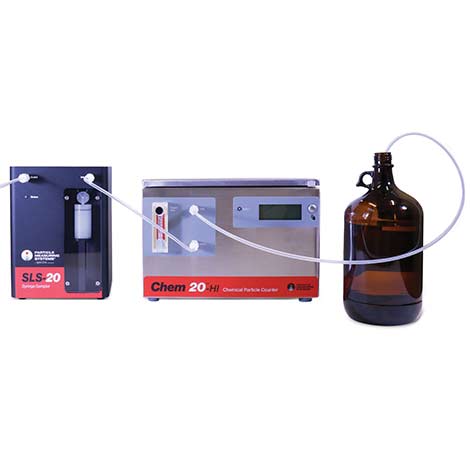As the critical particle size for semiconductor devices continues to shrink, the purity of the process chemicals used in their manufacture becomes increasingly important. Chemical suppliers will use a variety of techniques, including filtration, distillation, and ion exchange, to achieve the lowest possible particle contamination levels in their product.
Contamination in Chemical Supply Study
The Chem 20 particle counter is used to verify if the product’s particle levels are below acceptable limits before dispatching to end-users. Particle contamination is measured at the cleanest in-line sample point immediately before product is dispensed into the shipping container. Here, the Chem 20 particle counter from Particle Measuring Systems (PMS) is used during the filling of transportation containers of high-purity sulphuric acid. The opened supply valve feeds acid under pressure into the container and through the Chem 20, connected in parallel.
After the containers are filled, the supply valve is closed and a secondary post-fill measurement is performed. The container is first pressurized, allowing a small sample to flow back out of the container and through the Chem 20. Measuring here determines how many particles are added to the chemical from the filling process and the internal surfaces of the shipping containers.
Contamination Monitoring Results
Below you can see the results from a series of measurements made during filling and post-filling of nine ISO tank containers over a period of several weeks. The solid bars indicate the average particle concentration measured during the container filling process, and the shaded bars indicate the additional particles detected for each container during the post-fill measurements.
In general, the particle levels during filling were found to be relatively consistent. The particle concentration during Test A was found to be elevated due to particles shed by a dysfunctional valve upstream, later rectified. More particles were detected in the post-fill tests than during filling, with the majority likely from the inner surfaces of the shipping containers. The measurements also indicate there is variability in the cleanliness of individual containers. Test B showed an especially high level of particle contamination to the chemical, indicating a cleanliness issue with the container.
What’s Next?
The post-fill particle measurements indicate particle levels in the chemical after they’re received by the semiconductor manufacturer. They also show the detrimental effect that individual shipping containers have on particle contamination levels in the final chemical delivery, even if the chemical is very clean at the point of filling.
Learn more about the Chem-20 Chemical Particle Counter, and look forward to our next blog on Incoming Chemical Deliveries. Until next time, check out the full analysis of all semiconductor applications discussed in this blog series!
More information about Chemical Particle Counting
https://www.pmeasuring.com/blog/20-nm-reliable-data-collection/


